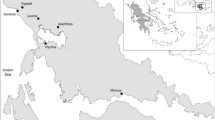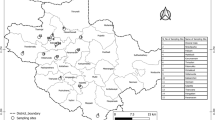Abstract
Monthly and inter-annual variations of prevalence (P) and intensity of infection (I) of Opechona sp. metacercariae were analyzed in the two most common scyphomedusae from south Brazil (~25.5°S, 48.4°W), between November 1997 and December 2004. Chrysaora lactea was highly parasitized (n = 817; P ≈ 41 %; I = 1–35), while Lychnorhiza lucerna hosted few metacercariae (n = 968; P ≈ 3 %; I = 1–3). Prevalence remained around 40 % in all size classes of C. lactea, and I positively correlated with its BD (bell diameter; Pearson, r = 0.34, p < 0.01); only those ≥5 cm had a parasite load ≥25. Prevalence was lower (<0.5 %) in small (<5 cm) L. lucerna and higher (13 %) in those with BD >20 cm. Overall annual P and I remained in similar levels among different years for both scyphomedusae, although peaking not exactly in the same month every year. Chrysaora lactea was parasitized throughout the year, but between July and December P reached the highest values (>40 % and up to 78 %). Lychnorhiza lucerna´s P was typically higher between July and November and lower or absent in the other months. Seasonality of the infection apparently was related to host availability and population dynamics; whenever the host was more abundant and/or larger, the infections tended to be higher. The high P and I in C. lactea indicate this medusa is a regular secondary host of Opechona sp., thus an important vector of this parasite to the final fish hosts. This relationship indirectly suggests feeding interactions between medusae and fish. A thorough literature review of metacercariae parasitizing scyphomedusae indicates that Semaeostomeae are the most studied (21 out of 28 records) and lepocreadiids the most common parasites.







Similar content being viewed by others
References
Alves DR, Paraguassú AR, Luque JL (2005) Community ecology of the metazoan parasites of the grey triggerfish, Balistes capriscus Gmelin, 1789 and queen triggerfish B. vetula Linnaeus, 1758 (Osteichthyes: Balistidae) from Rio de Janeiro, Brazil. Rev Bras Parasitol Vet 14(2):71–77
Averbuj A, Cremonte F (2010) Parasitic castration of Buccinanops cochlidium (Gastropoda: Nassariidae) caused by a lepocreadiid digenean in San Jose Gulf, Argentina. J Helminthol 84:381–389
Bavay A (1902) Note sur un Distome parasite d’une Méduse. Arch Parasit 5:199–200
Bonaldo RM, Krajewski JP, Sazima I (2004) Does the association of young fishes with jellyfishes protect from predation? A report on a failure case due to damage to the jellyfish. Neotrop Ichthyol 2:103–105
Brandini FP, da Silva AS, da Silva E, Kolm H (2007) Sources of nutrients and seasonal dynamics of chlorophyll in the inner shelf off Paraná State—Southern Brazilian Bight. J Coast Res 23:1131–1140
Bray RA, Gibson DI (1990) The Lepocreadiidae (Digenea) of fishes of the north-east Atlantic: review of the genera Opechona Looss, 1907 and Prodistomum Linton, 1910. Syst Parasitol 15:159–202
Browne J, Cribbs TH, Pitt KA (2013) Spatial variation in parasites of Cassiopea sp. In: Proceedings of the Fourth International Jellyfish Blooms Symposium, Programs and Abstracts, Hiroshima, p 41
Bush AO, Lafferty KD, Lotz JM, Shostak AW (1997) Parasitology meets ecology on its own terms: Margolis et al. revisited. J Parasit 83:575–583
Chaves PTC, Corrêa CE (2000) Temporary use of a coastal ecosystem by the fish, Pomadasys corvinaeformis (Perciformes: Haemulidae), at Guaratuba Bay, Brazil. Rev Bras Oceanogr 48(1):1–7
Daponte MC, Pertierra AG, Palmieri MA, de Nuñez MO (2008) Monthly occurrence of parasites of the chaetognath Sagitta friderici off Mar del Plata, Argentina. J Plankton Res 30:567–576
Diaz-Briz L, Martorelli S, Genzano G, Mianzan HW (2012) Parasitism (Trematoda, Digenea) in medusae from the southwestern Atlantic Ocean: medusa hosts, parasite prevalences, and ecological implications. Hydrobiologia 690:215–226
Girola CV, Martorelli S, Sardella NH (1992) Presencia de metacercarias de Monascus filiformis (Digenea, Fellodistomidae) en hidromedusas del Océano Atlántico Sur. Rev Chil Hist Nat 65:409–415
Kohn A, Fernandes BMM, Cohen SC (2007) South American trematodes parasites of fishes. Imprinta Express Ltda, Rio de Janeiro
Køie M (1975) On the morphology and life-history of Opechona bacillaris (Molin, 1859) Looss, 1907 (Trematoda, Lepocreadiidae). Ophelia 13:63–86
Kondo Y, Hirabayashi T, Okada S, Ohtsuka S, Ogawa NO, Ohkouchi N, Shimazu T (2013) Interspecific relationhips among jellyfish, trematodes and fish juveniles in the Seto Inland Sea, Japan. In: Proceedings of the Fourth International Jellyfish Blooms Symposium, Programs and Abstracts, Hiroshima, p 117
Lauckner G (1980) Diseases of cnidaria. In: Kinne O (ed) Diseases of marine animals. General aspects protozoa to gastropods, vol I. Willey, New York, pp 167–237
Lebour MV (1916) Medusae as hosts for larval trematodes. J Mar Biol Assoc UK 11:57–59
Marcogliese DJ (1995) The role of zooplankton in the transmission of helminths parasites to fish. Rev Fish Biol Fisher 5:336–371
Marcogliese DJ (2002) Food webs and the transmission of parasites to marine fish. Parasitology 124:S83–S99
Marcogliese DJ (2004) Parasites: small players with crucial roles in the ecological theater. EcoHealth 1:151–164
Marcogliese DJ (2005) Parasites of the superorganism: are they indicators of ecosystem health? Int J Parasitol 35:705–716
Martell-Hernández LF, Ocaña-Luna A, Sánchez-Ramírez M (2011) Seasonal occurrence of Opechona pyriforme metacercariae (Digenea: Lepocreadiidae) in Eirene tenuis medusae (Hydrozoa: Leptothecata) from a hypersaline lagoon in western Gulf of Mexico. J Parasitol 97:68–71
Martorelli SR (1991) Primeira cita de una cercaria tricocerca parasita de Dorsanum moniliferum (Mollusca: Buccinidae) para el Atlantico Sud-Ocidental. Aportes al conocimiente de su ciclo de vida. Neotropica 37:57–65
Martorelli SR (2001) Digenea parasites of jellyfish and ctenophores of the southern Atlantic. Hydrobiologia 451:305–310
Martorelli SR, Overstreet R, Heard R (2010) Proposed life history of a new faustulid digenea in the Gulf of Mexico involving ctenophores and jellyfishes as the second intermediate hosts. In: Proceedings of the Third International Jellyfish Blooms Symposium, Mar del Plata, p 71
Mianzan HW, Marí N, Prenski B, Sanchez F (1996) Fish predation on neritic ctenophores from the Argentina continental shelf: a neglected food resource? Fish Res 27:69–79
Mianzan HW, Pájaro M, Alvarez-Colombo G, Madirolas A (2001) Feeding on survival-food: gelatinous plankton as a source of food for anchovies. Hydrobiologia 451:45–53
Morandini AC (2003) Estrutura populacional de Chrysaora lactea e Lychnorhiza lucerna (Cnidaria, Scyphozoa) em amostras de plâncton, com a redescrição das espécies. PhD. Thesis, Universidade de São Paulo
Morandini AC, Silveira FL, Jarms G (2004) The life cycle of Chrysaora lactea Eschscholtz, 1829 (Cnidaria, Scyphozoa) with notes on the scyphistoma stage of three other species. Hydrobiologia 530(531):347–354
Morandini AC, Martorelli SR, Marques AC, Silveira FL (2005) Digenean metacercaria (Trematoda, Digenea, Lepocreadiidae) parasitizing “coelenterates” (Cnidaria, Scyphozoa and Ctenophora) from southeastern Brazil. Braz J Oceanogr 53:39–45
Nagata RM, Haddad MA, Nogueira Júnior M (2009) The nuisance of medusae (Cnidaria, Medusozoa) to shrimp trawls in central part of southern Brazilian Bight, from the perspective of artisanal fishermen. Panam J Aquat Sci 4:312–325
Niewiadomska K, Niewiadomska-Bugaj M (1995) Optimal identification procedure for Diplostomum paracaudum (Iles, 1959) and D. pseudospathaceum Niewiadomska, 1984 metacercariae (Digenea) based on morphological characters. Syst Parasitol 30:165–171
Nogueira Júnior M, Haddad MA (2005) Lychnorhiza lucerna Haeckel (Scyphozoa, Rhizostomeae) and Libinia ferreirae Brito Capello (Decapoda, Majidae) association in southern Brazil. Rev Bras Zool 22:908–912
Nogueira Júnior M, Nagata RM, Haddad MA (2010) Seasonal variation of macromedusae (Cnidaria) at North Bay, Florianópolis, southern Brazil. Zoologia 27:377–386
Nogueira Júnior M, Diaz Briz L, Haddad MA (2013) New records of Opechona sp. metacercariae (Digenea: Trematoda) on hydromedusae from south Brazil. Mar Biodivers Rec 6(e69):1–4
Ohtsuka S, Koike K, Lindsey D, Nishikawa J, Myiake H, Kawahara M, Mulyadi M, Mujiono N, Hiromi J, Komatsu H (2009) Symbionts of marine medusae and ctenophores. Plankton Benthos Res 4:1–13
Ohtsuka S, Kondo Y, Sakai Y, Shimazu T, Shimomura M, Komai T, Yanagia K, Fujita T, Nishikawa J, Miyake H, Maran BA, Go A, Nagaguchi K, Yamaguchi S, Dechsakulwatana C, Srinui K, Putchakarn S, Mulyadi A, Mujiono N, Sutomo S, Yusoff FM (2010) In-situ observations of symbionts on medusae occurring in Japan, Thailand, Indonesia and Malaysia. Bull Hiroshima Univ Mus 2:9–18
Prado-Rosas MC, Segura-Puertas L, Álvarez-Cadena JN, Lamothe-Argumedo R (2000) Opechona pyriforme metacercaria (Trematoda: Lepocreadiidae) in Eirene lactea (Cnidaria: Hydroidomedusae) from a reef lagoon in the Mexican Caribbean Sea. An Inst Biol Univ Nac Auton Méx, Zool 71(1):1–6
Rios EC (1994) Seashells of Brazil. Editora da Fundação Universidade do Rio Grande, Rio Grande
Rózsa L, Reiczigel J, Majoros G (2000) Quantifying parasites in sample of hosts. J Parasitol 86:228–232
Saville DH, Galaktinova KV, Irwina SWB, Malkova II (1997) Morphological comparison and identification of metacercariae in the ‘pygmaeus’ group of microphallids, parasites of seabirds in western palaearctic regions. J Helminthol 71(2):167–174
Stunkard H (1967) The life-cycle and developmental stages of a digenetic trematode whose unencysted metacercaria stages occur in medusae. Biol Bull 133:488
Stunkard H (1969) The morphology and life-history of Neopechona pyriforme (Linton, 1900) n. gen., n. comb. (Trematoda, Lepocreadiidae). Biol Bull 136:96–113
Stunkard H (1972) Observations on the morphology and life-history of the digenetic trematode Lepocreaium setiferoides (Miller and Northup, 1926) Martin, 1938. Biol Bull 142:326–334
Stunkard H (1980a) Successive hosts and developmental stages in the life history of Neopechona cablei sp. n. (Trematoda: Lepocreadiidae). J Parasitol 66:636–641
Stunkard H (1980b) The morphology, life-history, and taxonomic relations of Lepocreadium areolatum (Linton, 1900) Stunkard 1969 (Trematoda: Digenea). Biol Bull 158:154–163
Stunkard H (1983) The marine cercariae of the Woods Hole Massachusetts region, a review and a revision. Biol Bull 164:143–162
Thiel ME (1976) Wirbellose meerestiere als parasiten, kommensalen oder symbionten in oder an Scyphomedusen. Helgol wiss Meeresunters 28:417–446
Wallet M, Kohn A (1987) Trématodes parasites de poissons marins du littoral de Rio de Janeiro. Brésil. Mem Inst Oswaldo Cruz 82(1):21–27
Yip SY (1984) Parasites of Pleurobrachia pileus Müller, 1776 (Ctenophora), from Galway Bay, western Ireland. J Plankton Res 6(1):107–121
Acknowledgments
Drs. Arno Blankstein and Iracema Gomes provided part of the analyzed medusae. Students from the Cnidaria Laboratory of the Paraná Federal University helped during the field campaigns. MNJ received scholarship support from Conselho Nacional de Desenvolvimento Científico e Tecnológico (CNPq; 140945/2007) and Fundo de Amparo à Pesquisa do Estado de São Paulo (FAPESP; 2011/09880-8). Laura Carlino kindly revised the English text. Two anonymous referees provided useful suggestions.
Author information
Authors and Affiliations
Corresponding author
Additional information
Communicated by J. Purcell.
Rights and permissions
About this article
Cite this article
Nogueira Júnior, M., Diaz Briz, L.M. & Haddad, M.A. Monthly and inter-annual variations of Opechona sp. (Digenea: Lepocreadiidae) parasitizing scyphomedusae off southern Brazil. Mar Biol 162, 391–400 (2015). https://doi.org/10.1007/s00227-014-2584-6
Received:
Accepted:
Published:
Issue Date:
DOI: https://doi.org/10.1007/s00227-014-2584-6




